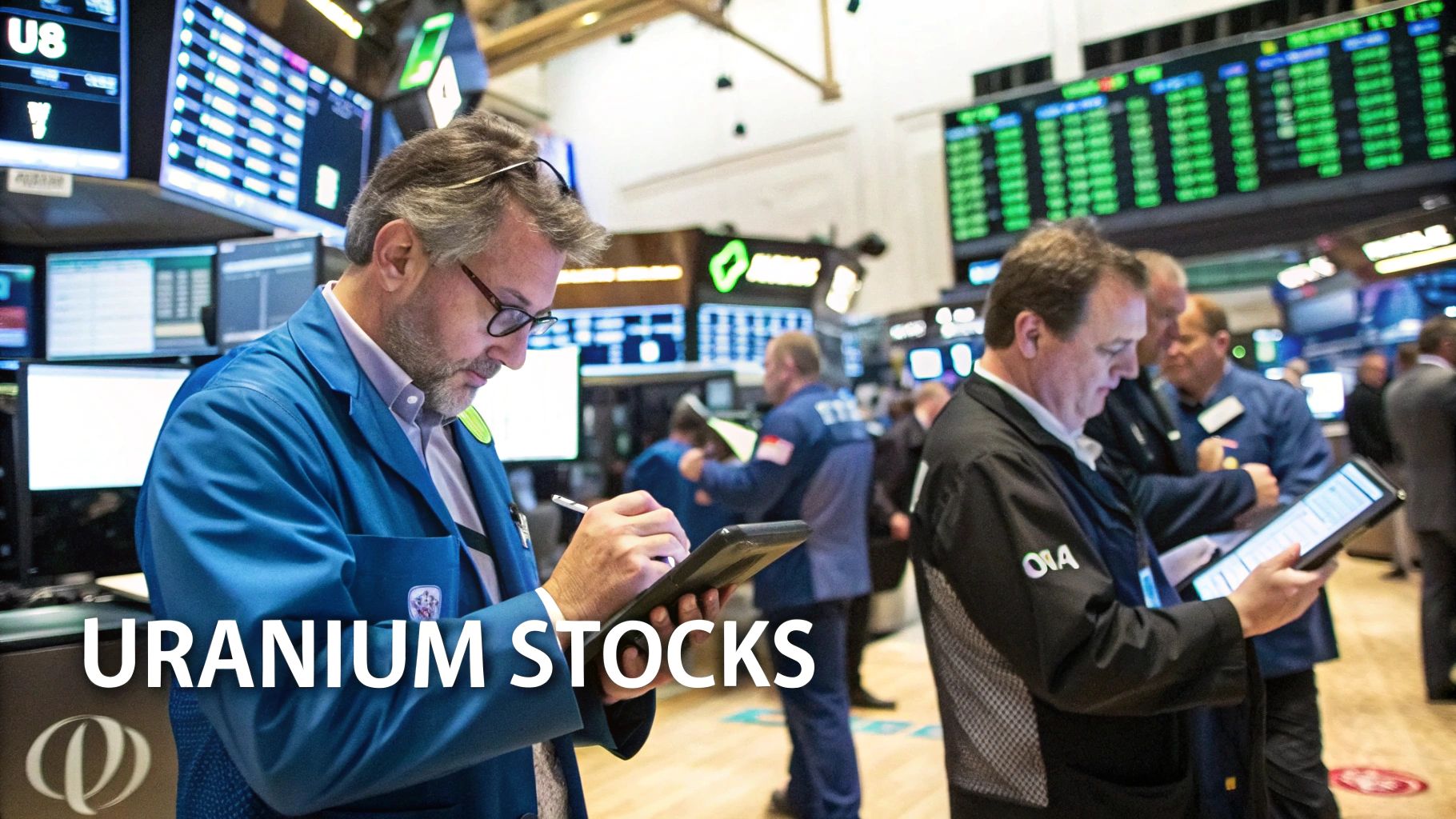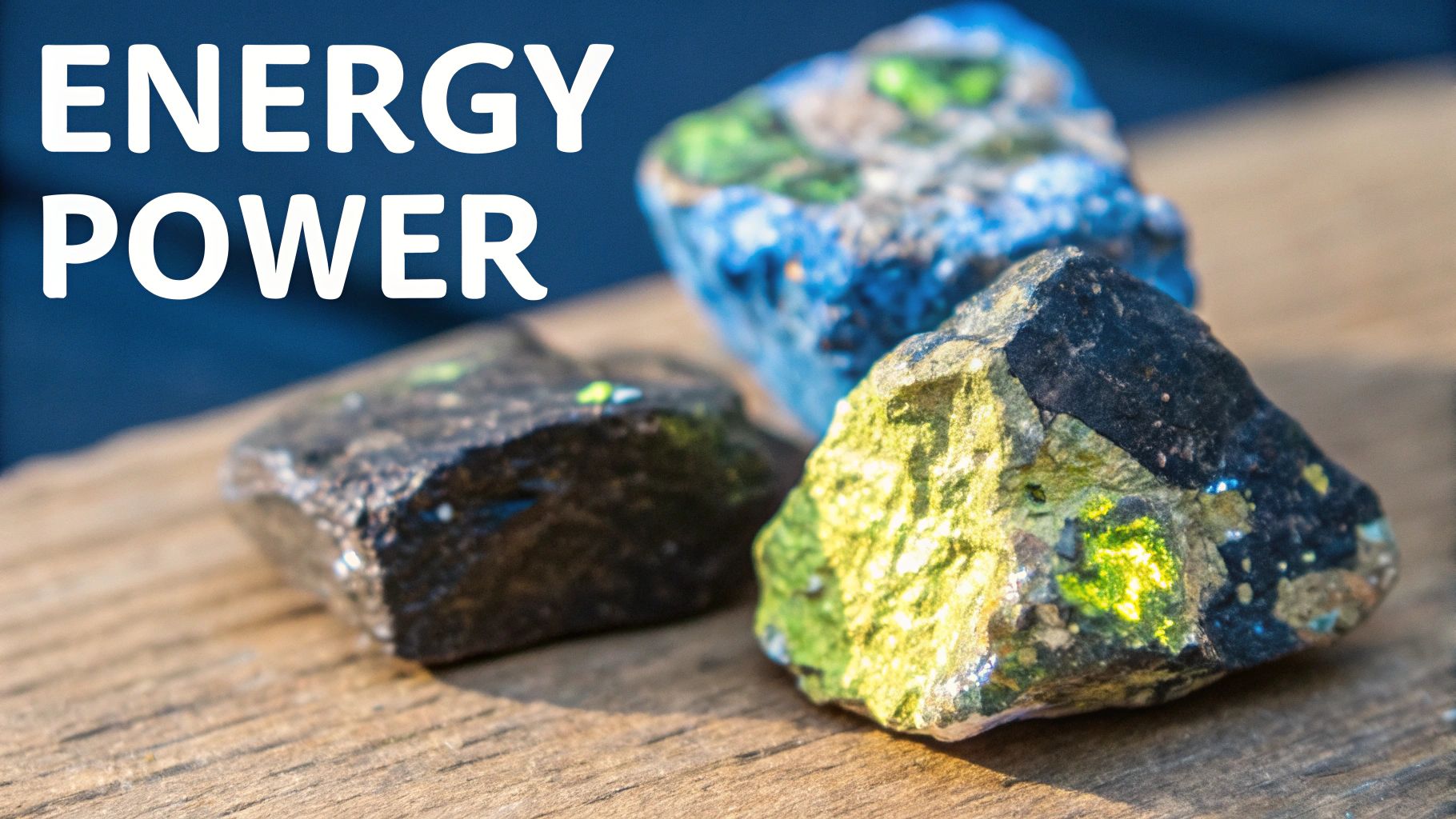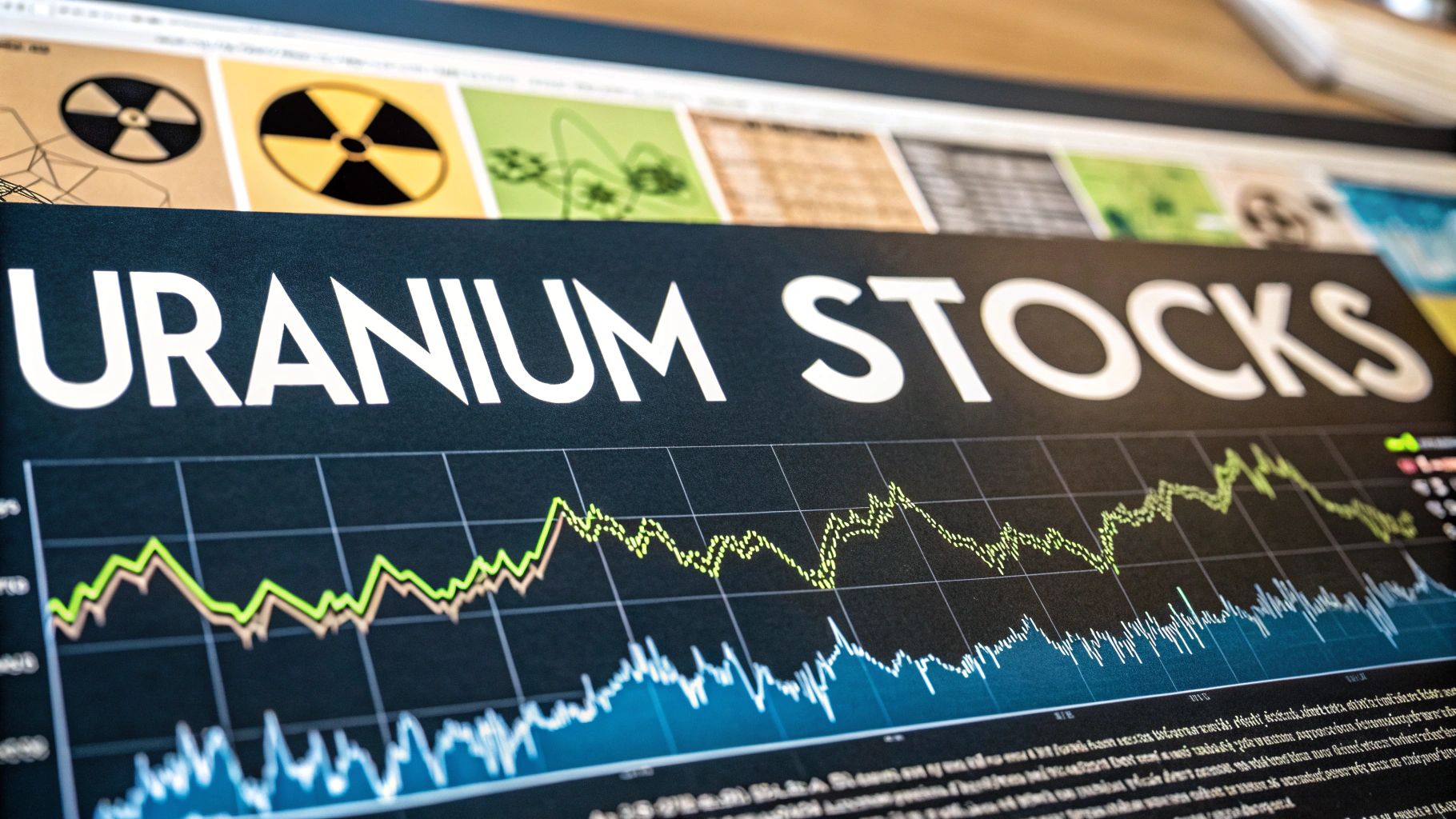Understanding Today's Uranium Stock Landscape

Uranium stocks offer investors a fascinating but complex market environment that operates quite differently from typical commodities. What makes uranium unique is its pricing mechanism – rather than being traded on public exchanges, uranium prices emerge from private deals between buyers and sellers. This creates an interesting dynamic that can lead to dramatic price movements. For instance, in 1988, uranium spot prices swung between $16.40 and $11.88, showing just how quickly market conditions can shift. For investors looking to enter this space, understanding these private pricing dynamics is essential since they directly impact stock performance.
Institutional Investment and Market Signals
The heavy presence of institutional investors adds another interesting dimension to uranium stocks. Many uranium companies see institutional ownership exceeding 64% – a notable sign of professional investors' faith in the sector. While this substantial institutional backing can provide stability, it also means individual investors need to watch these big players carefully. Their trading patterns and investment choices often signal important market shifts that smaller investors should consider when making their own decisions.
Global Events and Market Volatility
World events tend to have an outsized impact on uranium stocks compared to many other sectors. Changes in energy policies, shifts in international relations, or major industrial developments can quickly reshape market conditions. When countries announce new nuclear power initiatives, it often sparks fresh demand for uranium. Similarly, if a major mining operation unexpectedly closes or a country faces political upheaval, it can create supply shortages that push prices higher. Keeping track of these global developments helps investors anticipate potential market moves.
Interpreting Market Data for Uranium Stocks
Making sense of uranium stock data requires looking beyond standard stock metrics. While price-to-earnings ratios matter, equally important are factors specific to uranium companies – their mineral reserves, how efficiently they can mine, and their ability to secure long-term contracts. Successful investors in this sector often combine traditional market analysis with industry-specific knowledge. They track things like new reactor construction plans, mining technology improvements, and changes in government energy policies. By considering both market data and industry developments, investors can better spot opportunities while managing the unique risks of uranium stocks.
Mastering Uranium Stock Analysis

When investing in uranium stocks, traditional analysis methods often miss important nuances specific to this market. A thorough evaluation requires examining specialized metrics and understanding the unique characteristics that drive uranium company valuations. Let's explore the key factors that smart investors use to assess uranium stocks effectively.
Key Metrics for Uranium Stocks
Three main factors help determine a uranium company's true value and potential:
-
Mineral Reserves: The size and grade of uranium deposits directly impact a company's future production capabilities. Think of it like a bank account – more high-quality reserves mean greater potential returns. For example, a company with 100 million pounds of proven uranium reserves typically has more value than one with just 10 million pounds, assuming similar mining costs.
-
Production Costs: Mining efficiency makes a huge difference in profitability. Companies with lower operating costs can stay profitable even when uranium prices drop. It's similar to running a small business – if your costs are low, you can still make money when market conditions get tough. The best-positioned companies keep their extraction and processing costs well below market prices.
-
Contract Portfolio: Long-term supply agreements provide steady, predictable revenue streams. These contracts protect companies from short-term price swings, much like having anchor clients in a consulting business. The mix of contract lengths, prices, and terms reveals a lot about a company's financial stability.
These industry-specific metrics often tell us more about a uranium stock's potential than standard ratios like P/E.
Understanding Enterprise Value in Uranium
Looking at enterprise value (EV) gives us a fuller picture of what a uranium company is really worth. Beyond just market cap, EV factors in debt levels and cash on hand. This matters because uranium mining requires huge upfront investments. For instance, if two companies look similar based on stock price alone, but one carries heavy debt while the other has a clean balance sheet, the latter likely offers better value. EV helps spot these important differences.
Ownership Patterns: A Critical Indicator
Who owns the shares can tell us a lot about a uranium stock's outlook. When large institutions hold significant positions, it can mean more stable trading – but watch for any big changes in their holdings as signals of shifting sentiment. Even more telling is what company insiders do with their own shares. When executives buy more stock with their own money, it often shows confidence in the company's direction. Regular selling, however, might raise concerns. By combining these ownership clues with the metrics above, investors can make smarter decisions about uranium stocks.
Market Cycles and Historical Patterns in Uranium

Success in uranium stock investing requires a solid grasp of market cycles – the recurring patterns that shape this unique commodity market. The uranium market moves in response to real-world events like policy shifts, technological changes, and global developments. By studying these patterns, investors can make more informed decisions about when to buy and sell.
What Drives the Market
The uranium market responds to several key factors that create distinct cycles. Major policy decisions, like a country choosing to expand or phase out nuclear power, can dramatically shift demand. Supply fluctuates as new deposits are discovered and developed, while production costs and techniques evolve. These forces created clear boom-and-bust cycles throughout history – from the 1950s uranium rush during the Cold War to today's growing interest in nuclear power as countries seek clean energy solutions.
Learning from Past Recoveries
Market recoveries provide valuable insights for uranium investors. Take the aftermath of the 2011 Fukushima accident – uranium stocks fell sharply as several countries paused their nuclear programs. But as global energy needs grew and new reactor projects moved forward, the market steadily recovered. This pattern shows how uranium stocks can bounce back from setbacks when underlying demand remains strong. The stocks that led these recoveries often had strong fundamentals that helped them weather the downturn.
Smart Timing Strategies
While perfect market timing isn't possible, historical patterns can guide investment choices. One useful indicator is the relationship between uranium spot prices and stock performance. For example, in 1988, spot prices swung between $16.40 and $11.88, with stocks generally following similar patterns. But spot prices tell only part of the story – a company's reserves, costs, and contracts matter just as much for its stock performance.
Common Timing Mistakes to Avoid
Many investors hurt their returns by fixating on day-to-day price moves. This often leads to emotional decisions and missed opportunities. A better approach is to focus on long-term trends and company fundamentals. Look for uranium producers with large, high-quality deposits and efficient operations that can profit across market cycles. Pay attention to growth drivers like the rise of small modular reactors (SMRs), but maintain a diversified, patient approach. The uranium market's cycles reward investors who can look past short-term volatility and stay focused on the bigger picture.
Building Your Uranium Investment Strategy

Success in uranium stock investing comes from having a clear, well-researched strategy. This means knowing how to analyze market cycles, evaluate companies properly, and read global trends to make smart investment choices. Let's look at the key elements that make up a solid uranium investment approach that fits your personal situation and comfort with risk.
Defining Your Investment Goals and Risk Tolerance
Start by getting crystal clear on what you want to achieve with your uranium investments. Think about whether you're looking to grow your money over many years or aiming for quicker returns in the shorter term. Your goals will point you toward the right investments – someone focused on the long game might prefer established producers with proven reserves, while a shorter-term investor could look for more dynamic growth stocks. Just as important is being honest about how much risk you can handle. Since uranium stocks can swing up and down sharply, you need to know your comfort level with possible losses before deciding how much to invest.
Position Sizing and Diversification Within Uranium Stocks
Getting the size of each investment right is crucial for managing risk in your uranium portfolio. You'll need to decide what percentage of your total investments should go into each uranium stock you choose. It's also smart to spread your money across different types of uranium companies rather than putting everything into just one or two stocks. Consider mixing established miners with promising exploration companies and businesses involved in processing uranium or developing nuclear technology. This variety helps protect you if any single company runs into trouble.
Developing Entry and Exit Strategies
Clear rules for buying and selling are essential for success with uranium stocks. Your buying strategy should be based on solid research into market conditions and company fundamentals that match your investment goals. This could mean waiting for stocks to hit specific price targets or watching for positive signs like new long-term supply contracts. Similarly, know when you'll sell – whether that's at certain profit levels or when you spot warning signs like rising production costs that could hurt the company's future performance.
Managing Volatility and Maintaining Conviction
Price swings are common in uranium markets, so staying steady through ups and downs is key. This means keeping your cool during short-term price moves without abandoning your long-term plan. One helpful approach is to avoid checking stock prices too frequently, which can lead to emotional decisions rather than strategic ones. Focus instead on whether the basic reasons you invested still make sense – like strong company management and growing demand for nuclear power. Looking at past uranium markets, like the price swings of 1988, shows how these cycles tend to repeat. Understanding this history can help you stick to your strategy even when markets get rocky. You might also consider using options to protect against downside risk while potentially boosting returns. Success comes from combining thorough homework with a clear plan and the discipline to follow it through good times and bad.
Managing Risk in Uranium Investments
Success in uranium investing requires smart risk management. Instead of trying to avoid all risk, the goal is to make well-researched decisions that balance potential rewards against the unique challenges of this market. Let's explore practical ways to build and protect a uranium stock portfolio.
Understanding the Volatility of Uranium Stocks
Price swings are a defining feature of uranium stocks. Take Uranium Energy Corp (UEC) as an example – its stock has moved up and down by nearly 50% within a single year. These dramatic shifts stem from multiple sources: changes in energy policy around the world, new developments in nuclear technology like small modular reactors, and global political events. Understanding this natural volatility is key to planning your investment approach.
Diversification and Position Sizing for Uranium Stocks
The best defense against market uncertainty is a well-balanced portfolio. In uranium investing, this means spreading your investments across different types of companies in the sector. You might combine established miners that already produce uranium with smaller exploration companies showing promise. Adding some companies focused on processing uranium or developing nuclear technologies provides another layer of protection. Just as important is deciding how much to invest in each stock. Set clear limits on the percentage of your portfolio that goes into any single uranium investment based on how much risk you're willing to take on.
Using Options Strategies to Manage Risk
For those familiar with options trading, certain strategies can help generate steady income while limiting downside risk. Writing covered calls against stocks you own creates an income stream that can help offset losses if prices fall. Similarly, selling cash-secured puts sets a clear maximum loss while still allowing for profits when stock prices rise. While these approaches require more advanced knowledge, they offer precise tools for managing risk. Coverd can help simplify these strategies by providing clear data and making it easier to handle covered calls and cash-secured puts.
Monitoring Market Indicators and News for Uranium Investments
Keeping up with market developments is essential for making good uranium investment decisions. Watch uranium spot prices and industry news carefully – these often drive stock performance. For instance, major price movements like those in 1988 typically affected uranium stocks significantly. But don't stop at price tracking. Pay attention to broader trends like new nuclear plant construction, improvements in mining methods, and changes in government regulations. By combining thorough market monitoring with smart portfolio management and well-chosen options strategies, you can work to protect your investments while maintaining good potential for returns.
Capitalizing on Future Growth Catalysts
Understanding what drives long-term growth in uranium markets helps investors make smarter decisions. By examining global energy needs, new technologies, and market changes, investors can better position themselves to benefit from future opportunities in uranium stocks.
Nuclear Energy Adoption and the Uranium Market
More countries and companies are turning to nuclear power as they work to cut carbon emissions and provide reliable energy. This shift directly increases demand for uranium fuel. A recent example is Google's deal with Kairos Power to buy electricity from small modular reactors (SMRs). These newer, safer reactor designs point to growing acceptance of nuclear energy among major corporations. As more organizations follow this path, the need for uranium will likely grow.
Supply Chain Developments and Investment Opportunities
Changes in how uranium is processed and supplied create new possibilities for investors. For example, Urenco's expansion of its US enrichment facilities shows how companies are preparing for higher demand. At the same time, new processing methods, like Russia's pilot reprocessing facility in Zheleznogorsk, are making nuclear fuel production more efficient. These developments open up different ways to invest in the uranium sector. Success comes from identifying which companies are best positioned to benefit from these industry changes.
Institutional Investment: A Key Market Signal
When large investors put money into uranium stocks, it's worth paying attention. Currently, institutions own over 64% of shares in many uranium companies – a strong vote of confidence in the industry's future. Following what pension funds and investment firms do with their uranium holdings can provide helpful clues for individual investors. A surge in institutional buying might signal growing faith in certain companies, while selling could warn of potential issues.
Timing Investments for Maximum Returns
Making the most of growth opportunities requires good timing, even though perfect market prediction isn't possible. Looking at past patterns can help – like studying how uranium stock prices moved during major price swings such as those in 1988. But stock prices aren't everything. Smart investing means looking at each company's fundamentals too, including their uranium reserves, operating costs, and long-term sales agreements, along with broader market trends.
Are you ready to take your options trading to the next level? Coverd helps you understand and execute options strategies like covered calls and cash-secured puts. Get clear insights quickly to improve your returns while managing risk. Visit Coverd today to see how simplified options trading can work for you.

Leave a Reply